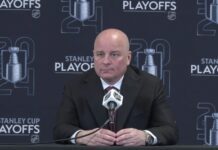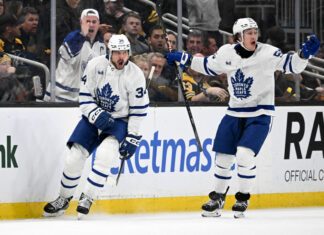Selected in the 2014 draft 188th overall by the Toronto Maple Leafs, Pierre Engvall will follow in the footsteps of Andreas Johnsson — a seventh-round selection the year prior in 2013 — by suiting up for his first-ever NHL game tonight.
Engvall’s path to this point has been a long road, with parts of three AHL seasons to his name and three years in Sweden. After making Toronto Marlies debut during the 2017 Calder Cup playoffs, Engvall did not return to North America until the tail-end of the following season, when he began to turn heads with eight points (4-4-8) in nine regular-season games.
Despite his lack of AHL experience, Sheldon Keefe trusted the Ljungby native on a checking line, which he grew into despite a lack of experience in the role. Eight points (3-5-8) during the Marlies run to a championship proved the regular season production was no fluke, giving Engvall a platform to build on for 2018-19.
2018-19 wasn’t always smooth sailing for Engvall, but in hindsight, playing several different roles probably helped him develop into a more rounded player. After spending approximately half the year in a checking role, Engvall was promoted to the top line as a center when both Adam Brooks and Chris Mueller were out of the lineup. The experiment at center continued for a while even when Toronto became healthier, and when Engvall was eventually bumped from the middle, he was moved to the wing in a top-six role.
The Swedish forward finished the 18-19 regular season with 32 points; not exactly leap-off-the-page production, but if you looked deeper into the numbers, there were positive signs to support the encouraging eye-test.
His 28 even-strength points were third-best on the team and he led all Marlies, including leading scorer Chris Mueller, with 18 even-strength goals. Deployed back in a bottom-six checking role during the most recent playoff campaign, Engvall still managed to produce reasonable numbers with seven points (1-6-7) in 13 games.
Fast-forward to this current season, you could make a strong argument for Engvall as the Marlies‘ best forward. He has struck up a formidable partnership with fellow Swede Pontus Aberg; despite a rotation of different wingers on their line, it hasn’t impacted either’s offensive momentum, with the duo sharing the team lead (16 points) in scoring at the time of the callup.
Engvall has again put up excellent production at even strength as he’s tied for the team lead in both points and goals (6-5-11) with Kenny Agostino at 5v5. He has also been trusted on both sides of special teams, featuring on the power play’s second unit and also rotating onto the penalty kill. Sheldon Keefe relies on him during most critical situations, including defending leads late in games, and he has shown a noticeable improvement in the faceoff dot over last season.
In terms of his overall game and skillset, Engvall is a fluid skater with a wide gait and his speed is deceptive. He has the ability to create space for himself with it, as he showcased this past weekend:
Engvall doesn't like what he sees, turns and passes it back to his defenseman to start the break-out again. Hollowell hits the outlet, Aberg finds Engvall in stride and they get a goal out of it.
Patience in the buildup allows the Marlies to tie it up. pic.twitter.com/lMiO4ey8kY
— Nick DeSouza (@NickDeSouza_) November 17, 2019
His assets include a heavy wrist shot that can beat goaltenders clean (see above), his strength on the puck on the cycle, and his ability to use his long reach over all three zones. The hope is Engvall’s speed with and without the puck can help out the Leafs‘ transition game, which hasn’t come as advertised so far this season.
When playing center he does not hesitate to go down low and assist with the D-zone breakout or even break it out all by himself with his strong skating stride, not many are catching up to him… pic.twitter.com/vMP6JPDEX6
— They did not wipe the slate or clear the canvas… (@RodBlanchard) November 18, 2019
“He has been skating like that through the neutral zone and driving play up the ice with shots and chances,” said Sheldon Keefe after the Marlies 4-3 win on Sunday. “He’s been really good for us in all areas of the game — power play, penalty kill, and we use him as a center. He’s found a way to improve his game on faceoffs… He’s a priority guy here. The season he had last season, we felt he is a guy who might be the next guy [for a promotion]. Especially for a guy who converted into a center, there is a lot of detail in that and he’s made big strides with it.”
Despite his size (6’5, 214lbs), Engvall is not a battering ram and Maple Leafs fans should not expect him to play an overly physical brand of hockey, although he‘s not totally averse to it. He may not see the ice well enough to successfully play center at the NHL level in terms of his overall playmaking ability; as such, he is probably best suited in a left-wing role, at least at this stage of his development. That is where he will start on a line with Frederik Gauthier and Nick Shore tonight.


![Sheldon Keefe Post Game, Leafs 3 vs. Bruins 2: “I loved [the Matthews] line, and I loved a lot about our game all the way through the lineup” Sheldon Keefe, Toronto Maple Leafs post game](https://mapleleafshotstove.com/wp-content/uploads/2024/04/keefe-pg-game-1-218x150.jpg)


![Jim Montgomery on adjustments for Game 2 vs. the Maple Leafs: “We need to spend more time in the offensive zone… We didn’t do a good job offensively at five-on-five [in Game 1]” Jim Montgomery, Boston Bruins practice](https://mapleleafshotstove.com/wp-content/uploads/2024/04/jim-montgomery-bruins-218x150.jpg)





















![Sheldon Keefe Post Game, Leafs 3 vs. Bruins 2: “I loved [the Matthews] line, and I loved a lot about our game all the way through the lineup” Sheldon Keefe, Toronto Maple Leafs post game](https://mapleleafshotstove.com/wp-content/uploads/2024/04/keefe-pg-game-1-100x70.jpg)




![Jim Montgomery on adjustments for Game 2 vs. the Maple Leafs: “We need to spend more time in the offensive zone… We didn’t do a good job offensively at five-on-five [in Game 1]” Jim Montgomery, Boston Bruins practice](https://mapleleafshotstove.com/wp-content/uploads/2024/04/jim-montgomery-bruins-100x70.jpg)


